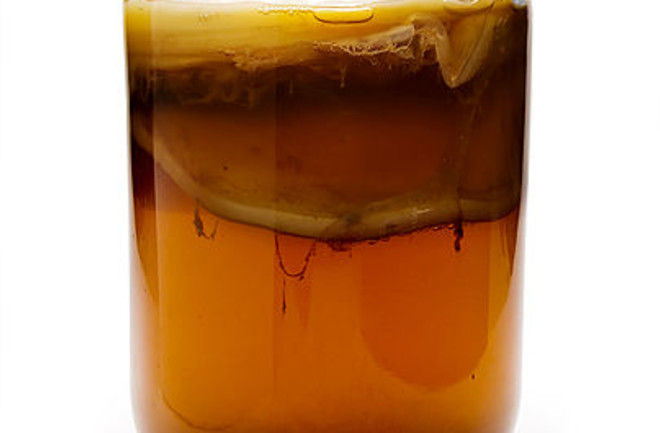Photo credit: Mgarten (Wikimedia Commons) At first glance, making kombucha sounds straightforward. After all, kombucha is fermented tea, which tells all you need to know about making it: take some tea and ferment it. Unfortunately, brewing kombucha is not that simple, as evidenced by the plethora of information and recipes found on the Internet. For those who have ever contemplated or even decided to begin brewing kombucha for the first time, don’t let the wealth of kombucha information intimidate you. Here, we break down the process of kombucha brewing and experimentation, supplying you with the scientific rationale for each step. Understanding the science of each stage may allow for a more successful and experimental brewing without having to rely on a recipe. 1. Making the tea base. The tea base is nothing more than sweetened tea, so it is easy enough to make. However, the amount of tea and sugar used will affect the flavor of the resulting kombucha. The exact proportion of water to tea to sugar can be modified to suit personal tastes. For the varieties of teas and sugars suitable for making kombucha, check out our previous post on the ingredients that go into making kombucha. In general, for every 1 cup of boiled water, steep 1 tea bag or 1 ounce of loose leaf tea; this should be left to steep for 3 – 5 minutes, with deviations depending on the type of tea and desired tea strength. Certain teas, such as green and white teas, have subtle flavor profiles that may result in a bland-tasting kombucha. To obtain a more concentrated flavor with delicate teas, use more tea bags, do multiple infusions, or combine the green or white teas with a more robust black tea. If you use tea bags, adding more of them can help increase the amount of flavor compounds in the brewed tea, creating a more concentrated green or white tea flavor. Avoid steeping the teas for too long; steeping teas longer than the recommended time results in the extraction of more bitter compounds. This over-extraction will create a more bitter tea base. The same caution equally applies to loose leaf teas. If you use loose leaf teas, multiple infusions will help concentrate the flavor without the risk of over-extraction. A proper method for multiple infusion involves steeping a large amount of tea leaves for 20 – 45 seconds in just enough hot water to cover the leaves. The brewed tea is removed, and another small amount of hot water is added to the leaves and steeped for another short amount of time. This can be repeated 3 – 15 times, depending on the type of tea. This method uses twice the amount of tea leaves with half the amount of hot water [1], essentially concentrating the flavor compounds that diffuse out of the tea leaves. Multiple infusions may not be as effective with tea bags; the tea fannings used for tea bags have small surface areas, and so most, if not all, of the flavor compounds will have quickly diffused into the water in the first steeping. Sugar can be added to the boiling water before or after steeping the tea, as long as the sugar source completely dissolves. Typically, 1 cup of sugar is added for every 4 cups of boiled water. 2. First fermentation. Once the tea is finished steeping and the sugar is dissolved, remove the tea bags or strain out the leaves – this is the completed tea base. Tossing the SCOBY (Symbiotic Culture of Bacteria and Yeast) into this freshly-completed tea base willy-nilly will negatively affect the fermentation process, as the microbes within SCOBY thrive best at specific temperatures and pH levels. To ensure a successful fermentation, the tea base has to be adjusted for temperature and pH create a suitable environment for the SCOBY.
Optimum temperature. Recall that SCOBY is alive; wait for the tea base to cool down to at least below 90°F (32°C) before adding SCOBY. A hot tea base would destroy the SCOBY microorganisms, resulting in a complete lack of fermentation. Conversely, do not add SCOBY to a tea base that has been refrigerated to below room temperature, as this would encourage the microbes to go into a dormant state, leading to a very sluggish fermentation process. The optimal temperature to add the SCOBY is between 77°F (25°C) and 90°F (32°C); , as this is the range which SCOBY microorganisms such as Acetobacter and yeast grow best [2,3].
Optimum pH. SCOBY bacteria are acidophiles, meaning that these bacteria thrive in acidic environments. Excluding herbal teas, the teas used for kombucha generally have low pH ranging from 2.9 to 6.3 [4,5]. While this is considered acidic, the pH of the tea base may not be at the optimal range for the Lactobacillus and Acetobacter that inhabit SCOBY, which thrive around pH 5.0 – 6.3 [6,7]. To remedy this, a starter liquid is added to the tea base, which is the liquid that the SCOBY was stored in. Since the starter liquid houses both Lactobacillus and Acetobacter, which produce acid by oxidizing sugar to lactic acid and ethanol to acetic acid, the starter contains a mixture of lactic and acetic acid at a buffered pH that is ideal for the SCOBY. In general, 1 cup of starter liquid is used for every 2 cups of tea base. If there is not enough starter liquid, then plain, store-bought kombucha can be used in lieu of the starter.

